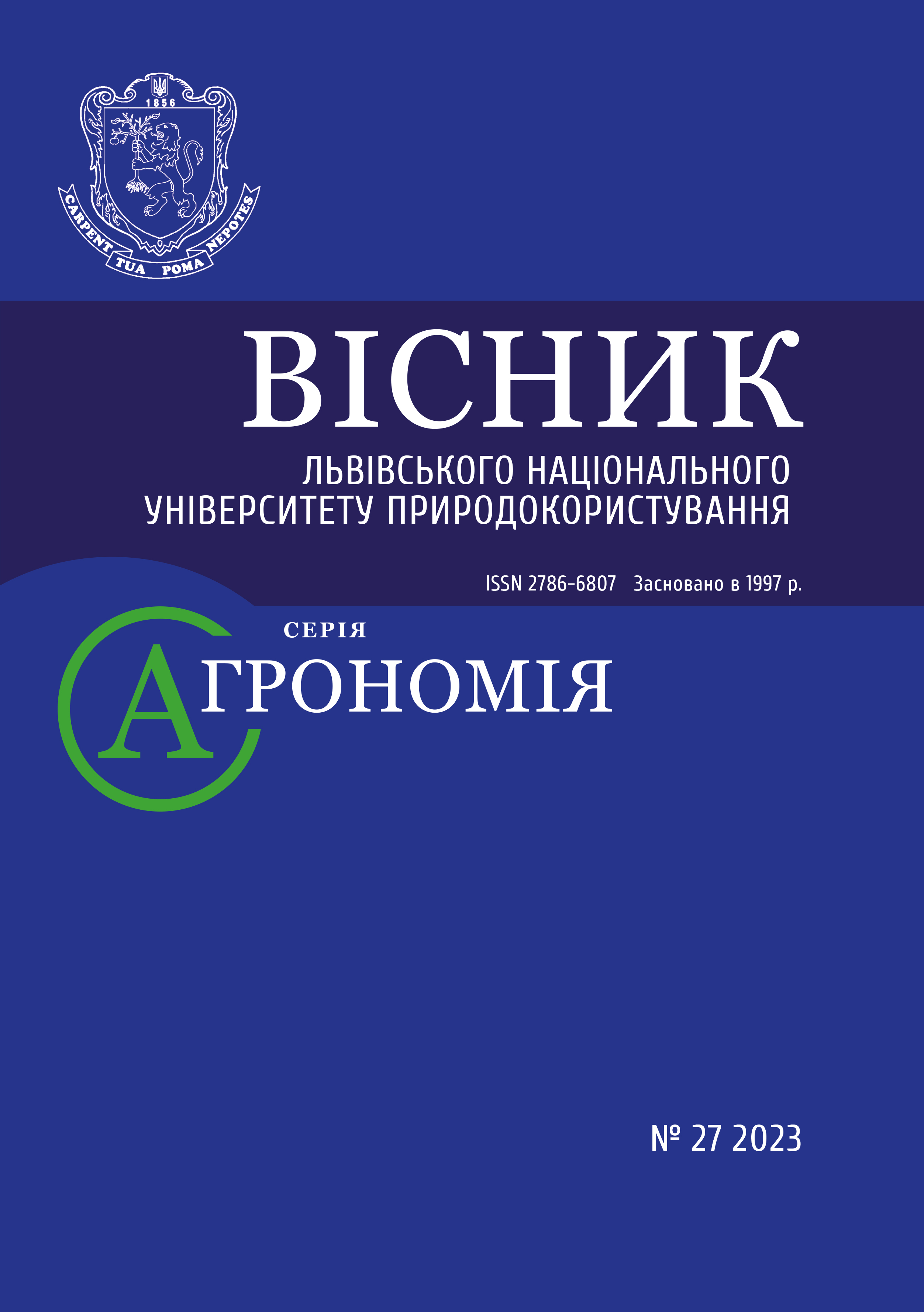THE RESULTS OF BREEDING THE SELECTION-VALUABLE POTATO HYBRIDS BY THE METHOD OF STEPWISE INTERVARIETAL HYBRIDIZATION
DOI:
https://doi.org/10.31734/agronomy2023.27.121Keywords:
potato, selection, step hybridization, intervarietal hybrids, selection-valuable traitsAbstract
To implement programs of applied potato breeding at Lviv NЕU, when creating the initial breeding material, the staged intervarietal crossings were carried out. Its idea was to combine a complex of valuable economic traits that were inherent in the original parental forms into one genotype.
As a result of the stepwise intervarietal hybridization in Lviv NЕU, several new hybrid forms of potatoes of different origins and maturing periods were created. The original parental forms for hybridization used potato varieties of Ukrainian selection, namely Borodianska Rozheva, Vodohrai, Hibrydna 14, Volia, Zakhidna, Zov, Lishchyna, Lvivianka, Oksamyt, Povin, Svitanok Kyivskyi, and foreign varieties, such as Nevskа, Suzorye, Aminca, Sante, hybrid SVP.
The task of the research was to give a comprehensive assessment of promising intervarietal hybrids of potatoes according to their valuable economic and biological characteristics so that the best forms could be recommended as candidates for new varieties.
The research was conducted during 2020–2022. 9 new potato hybrids of different maturity groups were used for the studies. Each of the hybrids and the corresponding standard varieties of potatoes were planted on land plots with a plant feeding area of 70×35 cm, which amounted to 40.8 thousand plants per 1 ha. The experimental sites were placed in triplicate, using a systematic method. The registered area of the site was 25 m2. Potato varieties of domestic selection were used as standards, in particular, Vodohrai variety – for the mid-early group, Volia variety - for mid-ripening, and Zakhidna – for mid-late.
It is established that the stepwise intervarietal hybridization allows combining potentially high productivity (1000 g/bush and higher), intensive crop formation with increased starch content in tubers (16–18 %), and high resistance to late blight (at the level of 7–8 points).
Basing on the conducted research of the comprehensive evaluation of the economic and biological characteristics of new intervarietal hybrids of potatoes, the mid-early hybrid 02/10-40 (Borodianska rozheva × Suzorye), the mid-ripening 11/4-1 (Zakhidna × Vodohrai) and the mid-late hybrid 16/17-1 [(Zakhidna × Sante) × (Volia × Lishchyna)] were marked as they significantly prevailed in the complex of economic and valuable characteristics of the corresponding standard varieties. It is proposed to continue further selection work with them according to the accepted schemes and potato selection, intensively multiply, and prepare to pass to the State variety tests as candidates for new varieties of the crop.
References
Basics of scientific research in achronology. Edited by V. O. Yeshchenko, Doctor of Agricultural Sciences. Kyiv-Diya, 2005. 286 p.
FAO: FAO Production Yearbook. Food and Agricultural Organization. United Nations Rome, 2014.
Food and Agriculture Organization of the United Nations, FAOSTAT. URL: http://www.fao.org. (Accessed August 25, 2023).
Honcharov M. D. Selection of potatoes for early maturity. Potato. Bila Tserkva. 2002. Vol. 1. P. 226–242.
Ilchuk L. A., Ilchuk R. V. Variety as a factor influencing the productivity and quality of potatoes. Foothill and mountain agriculture and animal husbandry. Lviv, 2002. Vol. 44. P. 37–44.
Kozhushko N. S., Dubovik V. I. Prospects for the development of potato growing. Bulletin of SNAU. Sumy. 2005. Vol. 12. P. 5–7.
Manolov I., Neshev N., Chalova V. Tuber Quality Parameters of Potato Varieties Depend on Potassium Fertilizer Rate and Source. Agriculture and Agricultural Science Procedia. 2016. Vol. 10. P. 63–66.
Methodological recommendations for conducting research with potatoes. Nemishaeve, 2002. 184 p.
Muzyka I. M. The use of stepwise intervarietal hybridization to create potato source material with selection-valuable characteristics. International Student Scientific Forum, October 4–6, 2022. Lviv, 2022. P. 76.
Osypchuk A. A. Current issues of potato selection. Potato farming. 2004. Vol. 33. Kyiv: Urozhai, 2004. P. 27–32.
Osypchuk A. A. Potato breeding at the beginning of the 21st century. Potato production of Ukraine. 2005. No 1. P. 7–8.
Osypchuk A. A. Results and tasks of potato breeding in Ukraine. Potato farming. 2002. No 31. P. 15–20.
Shelepov V. V. et a. The variety and its value in increasing productivity. Varietal testing and protection of rights to plant varieties. Kyiv: Alefa, 2006. P. 140–144.
Sihariova D., Chabanov A., Taktaiev B. The role of resistant varieties in the protection of potatoes. Agrarian week. 2014. No 14. P. 32–33.
Taran S. Factors of the pathological process and formation of the causative agent of late blight of potatoes. Potato planter. 2003. No 1. P. 18–19.
Zaviriukha P. Potato breeding at Lviv Agricultural University: history and results. Bulletin of LNAU: agronomy. 2018. No 22. T. 1. P. 63–79.
Zaviriukha P. D. Potato breeding at Lviv NAU: results and prospects. Innovative development of agro-industrial complex: problems and their solutions. Zhytomyr: Zhnaeu, 2015. P. 45–50.
Zaviriukha P., Kokhanets O., Kosylovych H. Disease-resistant varieties as the basis of ecological potato growing. Bulletin of Lviv NAU: agronomy. 2013. No 17 (2). P. 208–215.
Zaviriukha P. D., Muzyka M. M. Results of creation of intervarietal hybrids of potatoes with a complex of economic and valuable traits. In the collection: Agrarian education and science: achievements and development prospects. Bila Tserkva, 2022. P. 37–40.
Zaviriukha P. D., Muzyka M. M. Selection of potato hybrids with intensive crop formation and other valuable economic traits. In the collection: Young science in Volyn: research priorities and perspectives. Lutsk, 2022. P. 62–65.
Zholudenko O. V. Phytophthora of potatoes. Protection of plants. 2011. No 10. P. 22–24.


